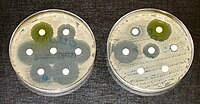
Photo from wikipedia
There is limited evidence to support pharmacogenetic (PGx) testing in children. We conducted a retrospective review of PGx testing among 452 patients at an academic children’s hospital to determine the… Click to show full abstract
There is limited evidence to support pharmacogenetic (PGx) testing in children. We conducted a retrospective review of PGx testing among 452 patients at an academic children’s hospital to determine the potential utility of PGx in diseases of childhood and to identify targets for future pediatric pharmacogenetic research. An actionable gene‐drug pair associated with the 28 genes tested (Clinical Pharmacogenetics Implementation Consortium (CPIC) level A or B, Pharmacogenomics Knowledge Base (PharmGKB) level 1A or B, or US Food and Drug Administration (FDA) recommendation and a PharmGKB level) was present in 98.7% of patients. We identified 203 actionable gene‐drug‐diagnosis groups based on the indications for each actionable drug listed in Lexicomp. Among patients with an actionable gene‐drug‐diagnosis group, 49.3% had a diagnosis where the drug was a therapeutic option and PGx could be used to guide treatment selection. Among patients with an associated diagnosis, 30.9% had a prescription for the actionable drug allowing PGx guided dosing. Three genes (CYP2C19, CYP2D6, and CYP3A5) accounted for all the gene‐drug‐diagnosis groups with matching diagnoses and prescriptions. The most common gene‐drug‐diagnosis groups with matching diagnoses and prescriptions were CYP2C19‐citalopram‐escitalopram‐depression 3.3% of patients tested; CYP2C19‐dexlansoprazole‐gastritis‐esophagitis 3.1%; CYP2C19‐omeprazole‐gastritis‐esophagitis 2.4%; CYP2D6‐atomoxetine‐attention deficit hyperactivity disorder 2.2%; and CYP2C19‐citalopram‐escitalopram‐obsessive‐compulsive disorder 1.5%. PGx could be used to guide selection of current treatment options or medication dosing in almost half (48.7%) of pediatric patients tested. Mood disorders and gastritis/esophagitis are promising targets for future study of PGx testing because of the high prevalence of these diagnoses and associated actionable gene‐drug pairs in the pediatric population.
Journal Title: Clinical and Translational Science
Year Published: 2020
Link to full text (if available)
Share on Social Media: Sign Up to like & get
recommendations!